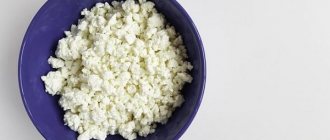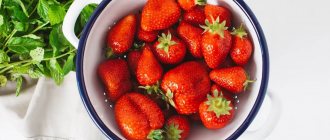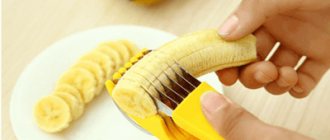Candied fruits are pieces of fruit boiled in sugar syrup. They are a traditional oriental sweet. The history of the delicacy is associated with the hot climate of countries in which sugaring made it possible to “preserve” fruits and preserve the harvest. Interestingly, in Rus' the product is called “dry jam”.
Fruits soaked in sugar syrup are used as decoration for decorating rolls, puff pastries, cookies, cakes, and pastries. In addition, they are placed as a filling in shortbread, yeast, biscuit, cake and butter dough.
The delicacy serves as a natural substitute for sweets, contains fiber and organic acids, which help remove toxins and toxic substances from the body, instantly replenish energy costs (due to the breakdown of fast carbohydrates), and increase blood glucose levels.
Production technology
Content:
- Production technology
- Chemical composition
- How to distinguish a natural product from a fake
- Benefits and harms
- Conclusion
Currently, candied fruits are not a scarce product. They can be purchased at any supermarket, confectionery shop or bazaar, both packaged and in bulk. However, today's candied fruits are bright “cubes and sticks”, usually dry and coarse-fibered, with a sickly sweet taste. The question arises: what are they made of? Manufacturers often limit themselves to the label “tropical sweets,” which does not convey anything specific. One can only guess what is hidden under this epithet...
Nutritionists do not recommend purchasing brightly colored candied fruits with a distinct fruity smell, since this indicates the introduction of a large number of dyes, flavors and preservatives into the product, the consumption of which will not make a person healthier. To protect yourself and your loved ones, it is recommended to prepare oriental sweets yourself. This is the only way to be sure of the quality and naturalness of the raw materials and the authenticity of the finished dessert.
Most often, candied fruits are made from apricots, plums, cherries, apples, pears, pineapples, carrots, pumpkins, lemon, watermelon and melon peels. However, zucchini, beets, cherry plums, grapes, peaches, and quinces can also be used as raw materials. The delicacy is prepared from fresh or frozen fruits, berries and even jam.
The technology for the production of oriental sweets can be divided into 4 stages: preparation of raw materials, blanching and aging in sugar syrup, drying, glazing or sprinkling.
Let's take a closer look at how to prepare candied fruits:
- At the first stage, the fruits or peels are washed, cleared of pulp and seeds, and cut into cubes or strips measuring 10 mm x 10 mm or 10 mm x 25 mm. Watermelon and melon skins are additionally kept in cold water for 2 days until the salty taste is completely eliminated.
- At the second stage, the fruits and peels are placed in boiling water for 10 minutes (blanching process), then they are removed from the liquid and poured with hot sugar syrup, brought to 90 degrees, with a concentration of 60% and left for 8 hours. This time is enough for the fruit to soak, “preserve” and become sweet in taste.
- The fruits are unloaded onto a wire tray with a cell diameter of up to 7 mm. You must wait until the syrup has completely drained. To speed up the drying of candied fruits, they are blown with cold or warm air and placed in dryers. At the same time, the dry matter content in the finished product must be at least 80%.
The syrup in which the fruits were aged is used to create jam and jam.
- The final stage of candied fruit production is sprinkling them with granulated sugar or glazing. In the first case, the fruits are rolled in sweet powder. The amount of granulated sugar should not exceed 15% of the weight of the fruit. The fruit processing process is as follows: dried cubes or sticks of berries are fed onto a perforated metal drum with a hole diameter of up to 7 mm, which rotates continuously. In it, sugar is evenly distributed over the surface of the candied fruit. In this case, sprinkling should be done manually.
In the second case, glazing is done in sugar syrup, the concentration of which depends on the type of fruit. Thus, for melon and watermelon rinds it does not exceed 80%, apricots, peaches and plums – 82%, pome fruits, citrus fruits, figs – 83%.
The prepared syrup is poured into two-body glazing boilers based on the calculation of 15 kg of dried fruits per 30 dm3 of sweet liquid. The candied fruits are mixed with a slotted spoon, boiled at a gentle boil, and replicated, as a result of which sugar crystallizes on the surface of the fruit and a transparent film is formed - glaze. Then the fruits are carefully removed and dried again.
Properly prepared candied fruits are covered with a shiny, glassy, light and transparent film of glaze through which the natural color of the fruit is visible. They do not contain sugar deposits and signs of spoilage (mold, fermentation) caused by the vital activity of organisms.
The shelf life of ready-made candied fruits is 6-12 months in a dry room at an ambient temperature of 5-20 degrees, relative humidity 75%. The candied fruits are stored in a glass container.
Calorie content of candied pineapple per 100 grams
Along with other options for candied products, candied pineapple is the lowest in calories. One hundred grams of the product contains only 91 kcal.
Energy component of the dish per 100 g:
- Protein – 1.7 g;
- Carbohydrates – 18 g;
- Fat – 2.2 g.
In stores and on the market, sweets are sold in the form of cubes, half rings, and whole circles. Prepared without the addition of harmful dyes and preservatives, pineapple pieces have a soft yellow color and a natural smell.
During the manufacturing process, all moisture is removed from the fruit as much as possible, so the finished delicacy has a fibrous structure and turns out to be somewhat harsh. Although the product is inferior in appearance and taste to its direct competitors, it is considered the most healthy.
Chemical composition
Fruits, vegetables, berries and their peels, cooked in concentrated sugar syrup, are one of the most discussed products of the 20th-21st centuries. Some claim that this is a healthy alternative to “chemical” candies, while others accuse the product of containing excessive glucose. Nutritionists insist that natural candied fruits, unlike their colored counterparts, contain healthy fiber necessary for normal digestion, and also serve as a supplier of carbohydrates and sugars, which are responsible for vigor, strength, energy and vitality of the body. This product has a natural color, inconspicuous without a pronounced odor.
The chemical composition of candied fruits depends on the type of raw material from which they were prepared. Apple and pear sweets contain a lot of iron, citrus fruits contain ascorbic acid, pumpkin and carrot sweets contain carotene.
Interestingly, candied fruits consist of 70% carbohydrates, 2-5% proteins, 1-2% fats.
100 grams of product contains 250-350 kcal. Vitamin and mineral composition of candied fruits
| Name | Nutrient content per 100 g of product, mg |
| Vitamins | |
| Ascorbic acid (C) | 5,0 |
| Niacin (B3) | 2,1 |
| Beta carotene (A) | 1,0 |
| Riboflavin (B2) | 0,2 |
| Thiamine (B1) | 0,03 |
| Macronutrients | |
| Potassium | 2043,0 |
| Phosphorus | 192,0 |
| Sodium | 141,0 |
| Calcium | 115,0 |
| Magnesium | 92,0 |
| Microelements | |
| Iron | 3,0 |
Based on the type of their surface, the following types of candied fruits are distinguished: glazed, candied and folding; according to configuration - leaves, segments, cubes, tablets, rings, sticks; by color - red, green, yellow, orange, purple. Interestingly, the color of candied fruits does not always depend on the raw materials used. Unscrupulous producers often make fruits from the hard, low-value pineapple core, which are tinted with aggressive dyes in the desired color and sold as kiwis and mangoes.
Nutritional value of candied fruits (BJU, etc.)
The delicacy contains quite a lot of calories. All data are averaged - a common figure for all varieties of candied fruits.
Calorie content
The calorie content of 100 grams of the product is 322 kilocalories with a daily value (RDV) of no more than 21%.
Including:
- proteins - 0.3 g,
- fats - 0.1 g,
- carbohydrates - 81.1 g,
- dietary fiber - 1.6 g,
- water - 17g.
BJU
BZHU: 1 x 0.3 x 207.3.
The share of proteins, fats and carbohydrates (BJC) in the total calorie content is represented by the ratio:
- B - 0% (0 g)
- F - 0% (0 g)
- U - 99% (81 g)
How to distinguish a natural product from a fake
To do this, place a piece of candied fruit in boiling water. If the water is colored, you have a low-quality product, the production process of which used chemicals. As a rule, such fruits are made from gelatin, dye, essence, and citric acid. Often they do not contain fruits and berries at all; they do not provide value for the human body, rather the opposite.
When dried, the fake has a rich color, very bright, attractive to the buyer. Under no circumstances should you purchase such candied fruits and give them to children. Don't put your baby's health at risk! Make them yourself using fresh fruit. In this case, the oriental delicacy will be absolutely safe to eat, without harmful food additives.
Candied fruits can be used as a substitute for confectionery products or as a decoration when decorating desserts.
Choosing candied fruits that you can and should eat on a diet
People resort to various diets to get their body in shape.
In this case, the amount of sweets consumed is limited or removed altogether. However, to effectively burn weight, it is not recommended to strictly limit yourself in food.
Otherwise, the body may go into storage mode, which will further complicate the process of losing weight.
To stay in shape, it is enough to replace high-calorie sweets (chocolate, candies) with easily digestible ones (dried fruits, candied fruits).
Benefits and harms
The abundance of sugar and heat treatment reduce the benefits of fruits and vegetables from which candied fruits are made, but do not completely deprive them. The pulp of candied fruits contains fiber, vitamins A, , C, iron, potassium, magnesium, calcium, phosphorus, sodium, which cleanse the body of toxins, normalize metabolic processes, and give strength and energy. The benefit of candied fruits made from watermelon and citrus peels comes down to the fact that they supply the body with pectins, which regulate blood glucose levels, intestinal function, and reduce the risk of developing malignant tumors.
The product contains a lot of sugar, so the delicacy should be excluded from the diet of diabetics, hypertensive patients, and people suffering from obesity. If storage conditions are violated and the expiration date expires, oriental sweets cannot be eaten, as pathogenic microorganisms begin to develop in them. And bright, delicious candied fruits containing dyes and preservatives can cause food poisoning.
Dried candied citrus fruits are strong potential allergens. If a person suffers from individual intolerance to the original product, most likely it will also appear to the candied fruit that is made from it.
People suffering from pancreatitis are allowed to consume oriental sweets in strictly limited quantities (up to 15 g per day), with caution, observing the body's reaction. If discomfort occurs in the digestive tract, the product should be discontinued.
Despite the fact that candied fruits are a source of vitamins (albeit not in large quantities), they are rich in sugars, so both adults and children should not get carried away with the product. Otherwise, the love of sweets can result in stomach ulcers, damaged teeth, the growth of malignant tumors, diabetes and obesity.
The daily intake of natural candied fruits should not exceed 30 g.
How to use it correctly on a diet
Nutritionists do not recommend strictly limiting your diet in order to avoid severe stress for the body, so candied fruits are considered a good alternative to sweets, but this product must be consumed correctly:
- Candied fruits have a high calorie content. People who want to lose weight can eat no more than 50 g in the first half of the day.
- Choose a product made from vegetables or unsweetened fruits.
- You can eat the delicacy in two ways: as a stand-alone dessert or adding it to various dishes.
- The product is especially recommended for complex weight loss for people who play sports or lead an active lifestyle. Contained beta-carotene, vitamin C and E help relieve fatigue.
Recommendations for eating and use
It is recommended to consume no more than 30 g of product per day . You can eat it with tea or coffee, or add it to different dishes.
This is a tasty and relatively healthy snack. It is better to eat them in the first half of the day - at this time carbohydrates are absorbed better and do not lead to excess weight.
In cooking
Candied fruits can be used as an independent sweet or as an ingredient in desserts . They are tasty, bright and beautiful, so dishes with them turn out decent.
They are added to baked goods, creams, ice cream, and cottage cheese. Very often they become a component of Easter cakes - butter or cottage cheese.
Easter with candied fruits has already become a classic menu item for the Resurrection of Christ.
They are added to preserves and jams . This is a natural preservative with excellent gelling properties, giving the preservation a unique taste.
This is especially true for candied citrus peels, which are also added to sweet and sour sauces for meat or poultry.
You can add them to porridge - this makes them much tastier and more beautiful. A great way to make your child love oatmeal or semolina.
The cooking process is similar to cooking jam, but involves a very low heat and takes longer, since you need to take a break of 8-12 hours between boiling .
This will preserve the texture of the product and better saturate it with sugar syrup. Candied fruits boil down more than jam. The syrup becomes viscous and thick.
The boiled pieces are transferred to a colander , where they need to be allowed to drain. This will also take several hours. Afterwards they are transferred to parchment and placed on a baking sheet sprinkled with granulated sugar.
The raw materials are dried in the oven at a temperature of 40 degrees . Don't overcook them or they will turn out too tough. Then the candied fruits are cooled and sprinkled with sugar or powdered sugar.
The finished product can be placed in a glass container and tightly closed with a lid or rolled up. You can wrap it in paper and cellophane and place it in a dry place. It can be stored under these conditions for up to six months .
Candied fruits from cheap seasonal vegetables - recipe from “Everything will be good”:
For weight loss
Candied fruits and weight loss are not very compatible concepts: these are simple carbohydrates, which contain a lot of sugar, with a high glycemic index.
But their calorie content is half that of everyone’s favorite chocolate and chocolate candies.
Therefore, if you want something sweet, you can allow yourself a handful - it’s unlikely to do much harm to your figure. You can add them to the same cereals that are included in the diet of those losing weight.
Candied fruits are a delicious and relatively healthy dessert . Choose them carefully, or better yet, cook them yourself to be sure of the purity of the product.
Of course, remember to have a sense of moderation and do not overeat on them: after all, these are sweets, and they are not the lowest in calories .
How to choose and prepare a sweet dessert
Natural candied fruits have a pale tint . If you notice bright multi-colored slices in a store window, it is better to refuse such a purchase, since this delicacy was certainly prepared with the addition of dyes that are harmful to health.
The density of the finished candied fruit should be medium, that is, it should not be too hard and dry, but the delicacy should not be wet either.
A too strong aroma and a spicy, bright taste clearly indicate the addition of essence during the preparation of the dessert. You will not get any benefit from such candied fruit.
It is a fairly well-known fact that you cannot make candied fruits and berries that are too soft; for example, you cannot caramelize strawberries or kiwis. Therefore, when a seller in a store or fruit shop tells you about candied fruits made from such fruits, this is an outright lie. Most likely, what you have in front of you is a regular pineapple with added dyes and flavors.
Carrot recipe
Candied carrots made from affordable carrots are very bright and tasty and serve as an excellent replacement for unhealthy sweets during the long winter.
Preparation next.
Composition of ingredients
For this healthy treat, you need to prepare the following ingredients:
- 0.5 kg of peeled carrots;
- 1 tbsp. granulated sugar;
- 100 ml water with lemon juice;
- 1 tbsp. l. lemon zest.
Step-by-step cooking process
Peeled and cut into equal size pieces of carrots should be placed in boiling water for 1-2 minutes, then removed and dried.
Further:
- In the meantime, you need to boil granulated sugar syrup with the addition of zest, and then place blanched carrots in it, cook for about 15 minutes. over low heat, and then remove the pan from the stove, let the mixture cool and brew.
- You need to repeat the procedure 2-3 more times so that the carrot slices acquire a translucent appearance.
- After this, place the candied fruits on a wire rack, allow the syrup to drain and dry in the oven or at room temperature.
- The finished delicacy should be generously rolled in powdered sugar or sand so that they do not stick together during storage.
What can I add?
You can add cardamom or fresh ginger root to the syrup, which will add new flavors to the dish.
How to serve a dish
You can serve carrot sweetness with tea instead of sweets or jam.
Useful properties for humans
What are the benefits of candied fruits? They receive all their beneficial properties from the raw materials they are made from.
Of course, fresh fruits, berries and vegetables are healthier because they retain all the valuable substances. When boiled, some of them are destroyed. But not all. The dessert receives many advantages from the original product.
It contains a lot of plant fiber , which helps improve intestinal function and cleanse the body of harmful substances.
There are vitamins and minerals in the composition , and the concentration of some of them becomes even higher due to shrinkage. They contribute to the overall strengthening of the body.
Most of the product's composition is simple carbohydrates . Their benefit is that they saturate the body with energy, fight loss of strength, and improve mental activity.
Be that as it may, this sweetness is much healthier than many others, such as candies or cakes . And it’s hard to argue with that.
Another interesting point. Candied fruits are made not only from berries and fruits, but sometimes also from vegetables (carrots, pumpkin, turnips, beets).
Vegetables cooked in sugar syrup are quite difficult to dry, which is why they are often doused with chocolate. It turns out to be a good combination: healthy filling and delicious chocolate shell.
The “Live Healthy!” program will reveal the benefits of candied fruits:
Pomelo
And we complete our list of these delicacies with such a fruit as pomelo. It contains almost 123 kcal, which is not so much compared to mango and papaya. But there are as many carbohydrates in pomelo as in mango - 98.2%.
However, this fruit does not contain any fat, which is also important for people who are watching their figure. Like all citrus fruits, pomelo contains substances that help burn fat deposits.
Potential dangers and contraindications
Candied fruits contain a lot of sugar, so diabetes is a clear contraindication to their consumption . They are also high in calories, so they are not recommended for overweight people.
It is also important to remember the risk of an allergic reaction . If it manifests itself in you on a specific fruit or berry, it will certainly make itself felt when you eat candied fruits.
Even in the absence of contraindications, remember moderation. Abuse leads to excess weight, caries , and diathesis.
How can dried apricots be harmful and beneficial for women? Read our article.
You can learn about the harm and benefits of tomato juice for the body from this material.
Our publication will tell you about the benefits, harms and safe dosage of carrot juice for men, women and children.
Candied fruit
Candied fruits are pieces of fruit boiled in sugar syrup.
They are a traditional oriental sweet. The history of the delicacy is associated with the hot climate of countries in which sugaring made it possible to “preserve” fruits and preserve the harvest. Interestingly, in Rus' the product is called “dry jam”. Fruits soaked in sugar syrup are used as decoration for decorating rolls, puff pastries, cookies, cakes, and pastries. In addition, they are placed as a filling in shortbread, yeast, biscuit, cake and butter dough.
The delicacy serves as a natural substitute for sweets, contains fiber and organic acids, which help remove toxins and toxic substances from the body, instantly replenish energy costs (due to the breakdown of fast carbohydrates), and increase blood glucose levels.
How to choose a good quality product
First, a few words about what candied fruits are - these are pieces of fruits, berries or vegetables that have been boiled in sweet thick syrup and dried in the oven or in the sun.
At first they were made only from citrus peels, but over time the range of candied fruits began to expand. Today they are even made from nuts .
Their homeland is the East: having appeared there, they were an alternative to jam.
Thanks to boiling and drying, the texture of the product was preserved. Its shelf life becomes quite long, since sugar is a good preservative.
Since candied fruits do not spoil over a long period, we can now try many exotic fruits.
Now manufacturers are tinting them, as they are initially pale.
Tinting makes the appearance of the dessert more attractive, but it becomes less beneficial for health.
To choose healthy candied fruits, consider the following recommendations :
- do not buy the product if it clumps together. This indicates a violation of either production technology or storage rules;
It is better to buy dull and nondescript products. Pallor is a sign that the manufacturer did not use artificial colors, and the benefits of sweetness are much higher;
excessive hardness of the product is a sign that its shelf life has expired;
It’s better not to buy candied fruits covered with glaze;
- Buy sweets in packages, not in bulk. There you will find all the necessary information about protecting the product from moisture and harmful microorganisms.
How to choose candied fruits:











